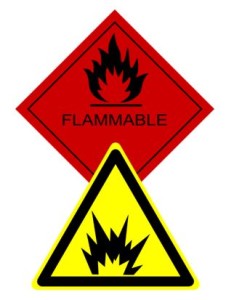Working in hazardous locations means you have to exercise serious caution regarding procedure, protocol, and equipment usage. What’s more, heating in hazardous locations takes all the more care and detail to make certain you aren’t adding fuel to a potential fire. This is why Powerblanket offers products certified to national safety standards.
 Difference between Class I Division 1 and Class I Division 2
Difference between Class I Division 1 and Class I Division 2
Many people who work in hazardous locations are familiar with these terms. For everyone else, here’s an explanation. The classifications referenced as CID1 and CID2 regard the operation of electronic equipment in hazardous locations. CID1 is the identifier used for locations where ignitable concentrations of flammable gases, mists or vapors could possibly exist under normal working conditions. This classification also covers locations where the same gases, mists or vapors may exist frequently due to repairs or maintenance in the area. It also includes potential scenarios where gases, mists or vapors could be leaked by faulty or damaged equipment.
CID2, on the other hand, represents all locations where concentrations of flammable gases and/or vapors and/or mists are present in the air under operating conditions outside of the norm. So CID1 covers areas where such hazards are normally present, and CID2 covers areas where such hazards aren’t normally present but certainly could be under abnormal circumstances. Most importantly, if a product is CID1 or CID2 certified, it means that product is safe to use in locations that are CID1 or CID2 rated hazardous locations.
We understand that hazardous location heating is nothing to take lightly. And we understand that heating products should be engineered to the highest standards of quality and safety. We’ve based our business on this simple reality and are able to customize our safe and innovative heating solutions to a myriad of industries because of it. Our custom heating solutions can be designed and certified to Class I Division 2 (CID2) safety standards. We are certified for all four gas Groups, A, B, C, and D and up to a T4 Temperature Classification.
Freeze Protection in CID1 and CID2 environments
Hazardous situations can present themselves even when the temperature is below zero. Flammable gases and material are not limited by how cold it is outside. It is very important that you know what options you have in keeping temperature sensitive material warm when some methods of doing so are restricted due to CID1 and CID2 location hazard ratings.
Insulation can help reduce the impact of cold weather on your equipment, but using a heater is more effective so long as the one you use does not compromise workplace safety.
Are heaters unsafe to use?
Some heating options are a really, really bad idea to operate in CID1 and CID2 environments. Any type of open flame heater, including propane heaters and torches, greatly increase the chance of ignition of flammable material, potentially leading to an explosion of catastrophic proportions. Unit heaters or location heaters are also a poor choice due to the lack of directional control over heat output.
Heat trace can sometimes be used, depending on what type of hazards are in the work area, but electrical wiring within the tape could be accidentally cut and exposed, igniting vapors and resulting in destruction.
The best choice for C1D2 hazardous location freeze protection is heated blankets, ideally ones manufactured by Powerblanket.
Powerblanket heating blankets 
Powerblanket provides products that are certified to C1D2 hazardous location equipment safety standards. So when it comes to heating in C1D2 hazardous areas, Powerblanket is both an efficient and safe choice. In addition to these ratings, Powerblanket products are also certified to UL, and CSA standards.
Powerblanket’s innovative approach to providing industry-specific heating solutions has helped customers save a lot of time and resources to safeguard and increase efficiency among the assets that keep their businesses running. So whether it’s freeze protection, viscosity maintenance, curing assistance, or some other heat-related dilemma, Powerblanket can help, even if you operate in a hazardous location.
For more information, call Powerblanket’s hazardous location heating specialists at 866.945.4203 or email us at info@powerblanket.com.
Keep your equipment running smoothly and prevent damage with Powerblanket's advanced hazardous location heating systems.






